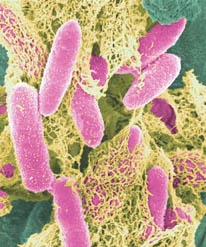Would the materials used in your project and/or your final product pose risks to the safety and health of team members or others in the lab?
The Escherichia coli TOP10 strain used in this project is a derivative of the non-pathogenic K-12 laboratory strain (see Fig.1.). The likelihood of a human becoming ill from working with this bacterium is therefore low. The most probable route of transmission would occur by accidental aerosol formation or ingestion. The Environmental Protection Agency states the strain is poorly retained in the human gut, so the chance of it to become pathogenic by mutations is low (EPA, 2011;Jump to References). Mainly for these reasons, this organism is also classified as Bio-Safety Level 1.
When an infection occurs nonetheless, it is important to note that this part of the project involves the periodic oscillation of an extracellular concentration of a quorum sensing molecule, N-(β-ketocaproyl)-L-Homoserine lactone (an Acyl Homoserine Lactone). The AHL compound is made by the enzyme that derives from the Vibrio fischeri luxI gene. Quorum sensing molecules play a role in many bacterial infections. This means successful transfer of the oscillator BioBrick device to a pathogen could possibly increase its quorum sensing-related pathogenicity. To get an impression where such pathogenic organisms are found we let the environmental BLAST of NCBI search for luxI homologous regions in Metagenomes (Zhang, Schwartz, Wagner, & Miller, 2000; Altschul, et al., 1997; Jump to References). In marine environments and in farm soils in the U.S.A, environmental representative organisms appeared to have a luxI-like gene. By using other BLAST searches we found human pathogens with a significantly corresponding luxI gene (Altschul, et al., 1997; Zhang, Schwartz, Wagner, & Miller, 2000; Altschul, et al., 2005; Jump to References). These pathogens are not representatives of the human gut flora, but they might infect humans by means of contaminated water or food. The pathogens found by the latter BLAST searches include mainly Vibrio species, for example V. cholerae, capable of causing gastroenteritis. Because of this, the researchers that handle the modified E. coli will be held on close watch. They should be removed from the lab work in case they have the symptoms of gastroenteritis. Additionally, two fish pathogens and a coral pathogen harbor a gene bearing significant similarity to the luxI gene contained in the Synchroscillator BioBrick system.
 "
"



